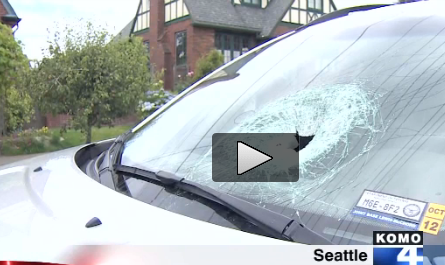Over the weekend, reports KOMO TV, a family was driving I-5 near Northgate when a chunk of concrete from the road flew up, smashed through the windshield, and hit the driver. “The rock hit me so hard in the chest, it literally took my breath away,” Henry Jessop told KOMO.
What may take your breath away is the response from Washington Department of Transportation‘s Paula Hammond: “As our transportation system has more wear and tear on it, and as we go longer without revenue dollars to just take care of the system that we have, we’re unfortunately going to see more of this kind of thing.”
You may well ask why.
Here is WSDOT’s budget for the 2011-13 biennium. About 27 percent of the $9.4 billion comes from gas taxes (37.5 cents per gallon), the rest from bonds, licenses and fees, and ferry fares. In 1921, when Washington State began implementing a gas tax, it was just one cent per gallon. But throughout the 1950s and ’60s, the state’s gas tax in today’s dollars was higher than it is today. As a percentage of the price of gas, today’s tax is even more negligible: if you pay more than $3.75/gallon, it’s just ten percent or less. In 1960, it was 24 percent of the retail price.
Combine that with declining federal dollars, and you just get less. Yet new roadwork hasn’t gotten less expensive. Take the 520 bridge replacement. With just $2.43 billion of its total anticipated $4.65 billion cost “in hand,” WSDOT is pushing ahead with construction. State gas taxes fund about twelve percent of the bridge’s cost. And then there’s the Alaskan Way Viaduct replacement project, which is budgeted for just over $3.1 billion. That draws down $1.7 billion of gas tax funds. (The less expensive surface/transit/I-5 option contained funds to deal with the I-5 bottleneck through Seattle–the tunnel plan does not.)
Meanwhile, WSDOT currently has 230 separate maintenance projects on its “backlog of underfunded and unfunded highway preservation needs,” that it hopes to deal with using ARRA funds. In Seattle, the situation is no better, due to some of the same pressures. SDOT gets funding from WSDOT, for one thing, so state gas taxes play a part, but they also have the tension between expensive new projects and maintaining the roadways we already have. To date, maintenance has taken a back seat.

God I hate local TV news. “like a gunshot.”
Yeah, now’s the time to draw a parallel between getting shot by a gun and a piece of pavement flying up and into a car and knocking a person’s breath.